On August 13, 2024, the Cabinet of Ministers of Ukraine adopted National Renewable Energy Action Plan until 2030 and the action plan for its implementation. Therefore, the share of renewable energy sources (RES) in gross final energy consumption in 2030 will up to 27%:
- in heating and cooling systems – 33%;
- in electricity generation – 29%;
- in the transport sector – 17%.
The National plan includes the implementation of 38 measures to achieve these targets, structured according to the following objectives:
- Development of RES in electricity generation | Funding: $12.6 billion (for the development of RES generation capacities based on biomass and biogas: $1.681 billion);
- Development of RES in heating and cooling systems | Funding: $6.7 billion (for the development of RES heating capacities: $3.419 billion).
- Increasing the use of energy carriers obtained from RES in the transport sector | Funding: $1.25 billion (for the use of bioethanol in the transport sector – $450 million, biodiesel – $19 million, biomethane – $2 million).
- Regulatory and organizational support for the development of RES.
As we can see, the bioenergy sector in Ukraine has significant potential for development, playing a crucial role in achieving the National Plan’s goals. This is due to the climate conditions, the prospects of the agricultural sector, and the availability of the necessary workforce.
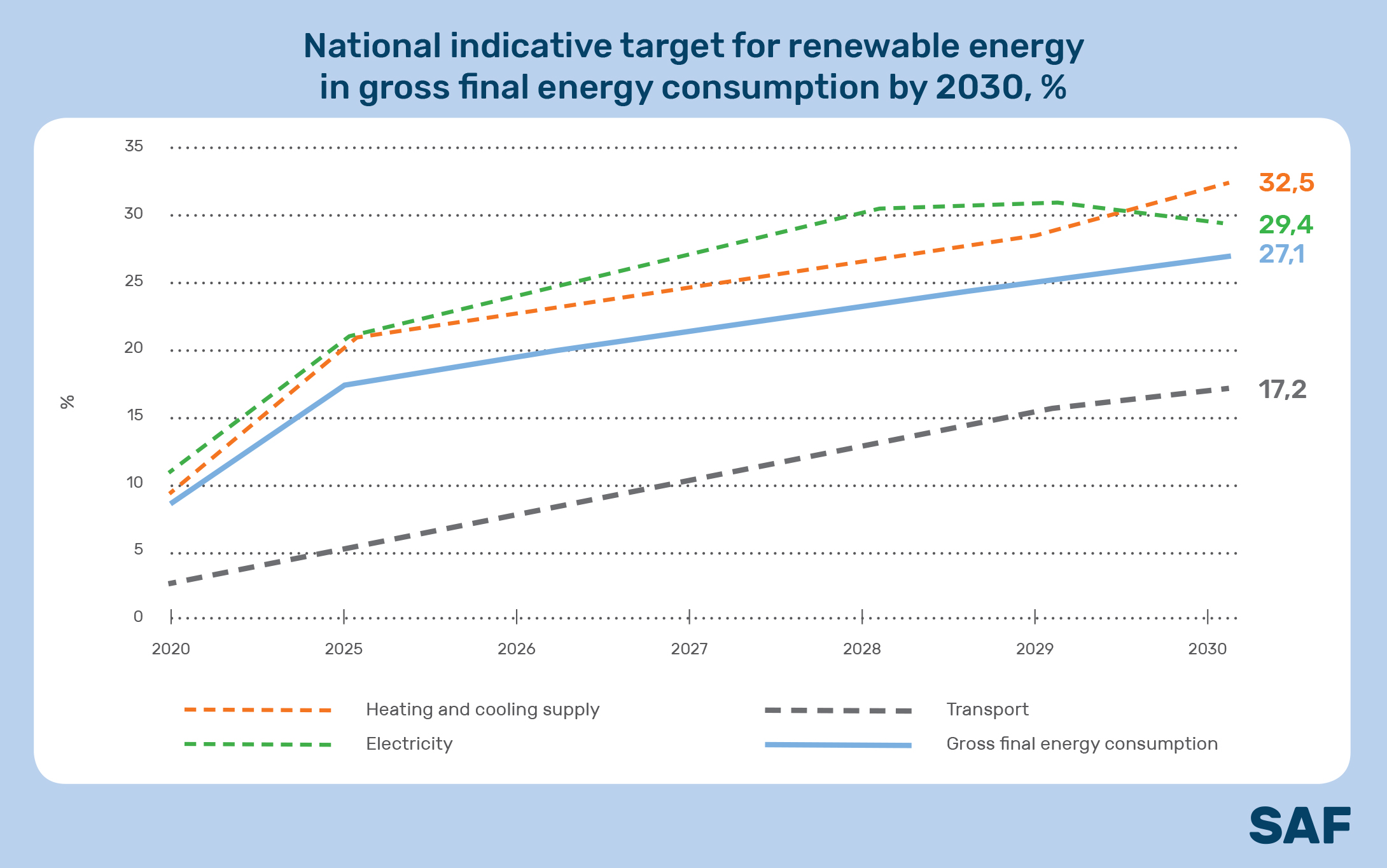
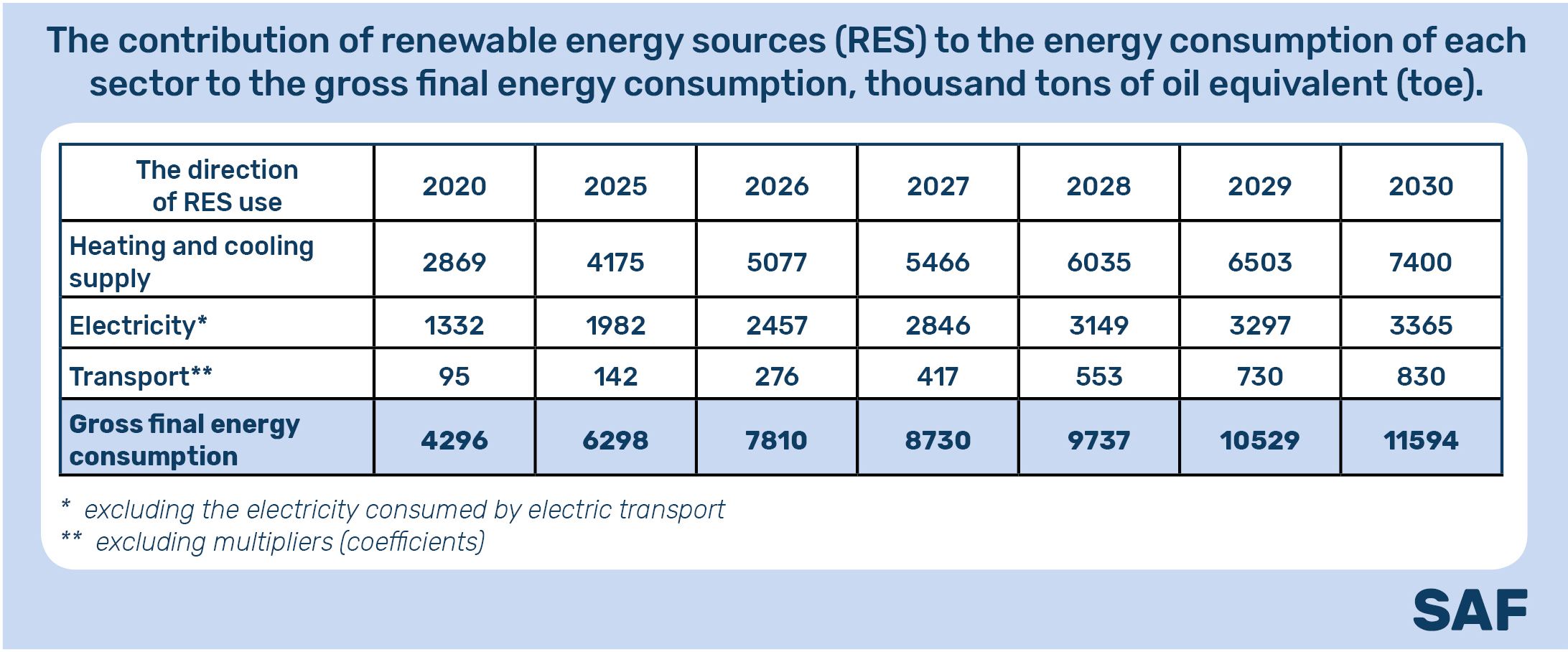
These types of biomass have the greatest energy potential in Ukraine:
- agricultural residues (primary — generated during the harvest, secondary — generated at enterprises during crop processing, animal manure);
- energy crops (for the production of solid biofuels and biogas).
Let’s consider the bioenergy development goals in the National Renewable Energy Action Plan up to 2030 in the following areas: heat energy production, electricity generation, and the use of biofuels in the transport sector.
Heat energy production
Currently, bioenergy is the most widely used among other RES in heating and cooling systems. The share of thermal energy from biomass in Ukraine is about 98% of all renewable thermal energy (2,797 thousand tons of oil equivalent (toe) in 2020.
It is planned that in the structure of renewable energy consumption in the heating and cooling sector, the contribution of biomass will amount to 5,749 thousand toe per year, and biogas – 235 thousand toe per year by 2030, with a total gross final consumption of energy from RES reaching 7,400 thousand toe per year. Thus, the share of biomass together with biogas will account for nearly 81% of all RES in this sector by 2030.
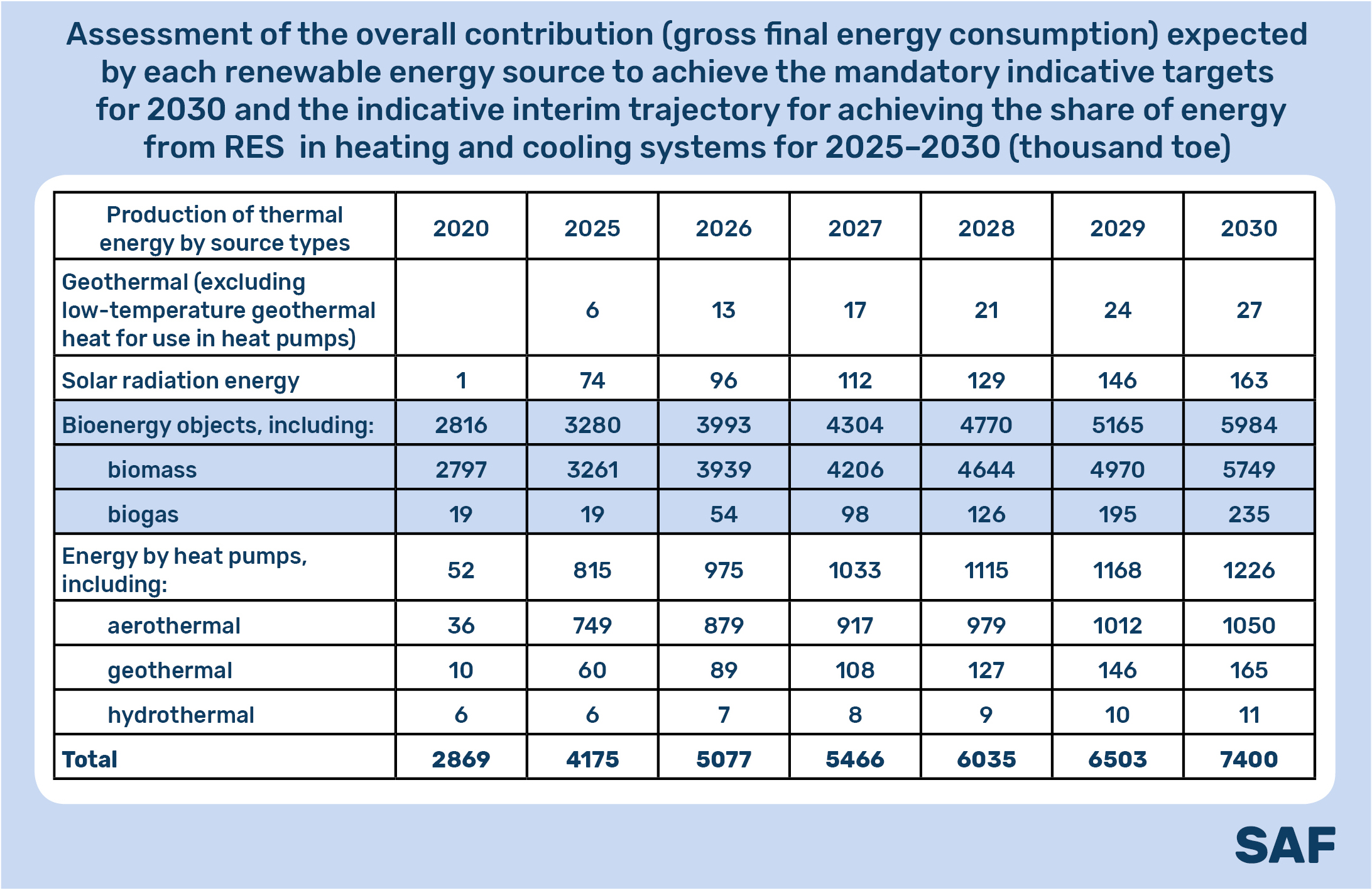
To stimulate the production of heat from renewable energy sources, the Verkhovna Rada of Ukraine amended the Law of Ukraine ‘On Heat Supply’. Accordingly, the tariff for heat energy from alternative sources is set at 90% of the current tariff. However, it is necessary to consider the volatility of natural gas prices and the setting of tariffs below production costs. That is why it is essential to grant producers of heat energy from alternative sources the right to choose the method of tariff calculation, specifically allowing for establishment on general terms.
The development of bioenergy has increased the volumes of renewable heat energy production. The significant potential of this sector:
- solid biomass – 35.3 million toe per year;
- biogas – 1,609 thousand toe per year.
At the same time, conditions must be created to ensure a reliable fuel supply for heat energy facilities.
Currently, the solid biofuel market faces challenges: price instability, low quality, and unreliable supply. The mechanism for organizing the biofuel market in Ukraine should be the use of an electronic platform, where all interested producers and consumers can trade biofuels. An example of this could be the Baltpool exchange in Lithuania. The introduction of the exchange will allow for:
- creating a transparent and competitive biofuel market in Ukraine;
- reducing biofuel prices;
- provide a stable supply of biofuel to generating capacities;
- attracting foreign investments into Ukraine’s bioenergy sector.
Energy plants grown on low-productivity lands are a promising renewable energy source, in addition to the available wood biomass. They are more resilient to drought conditions and require less or no use of chemical pesticides. In Ukraine, over 500,000 hectares of land require conservation. By cultivating energy crops on these lands with an average yield of 11.5 million tons per year, it would be possible to replace up to 2.7 billion cubic meters of natural gas annually. Additionally, this will help restore the fertility of the soils itself. At the beginning of 2024, only 6,500 hectares of marginal lands were used for energy crops.
Another potential renewable source for heat energy production could be biomethane, which can replace natural gas as a complete substitute.
Moreover, in the context of negotiations for EU accession, it is necessary to implement a mechanism for issuing guarantees of origin for heat energy produced from renewable energy sources, in accordance with the requirements of Directive RED III (Renewable Energy Directive III).
Electricity generation
The growth dynamics of electricity production using biomass and biogas are lower compared to the application of other renewable energy sources. At the beginning of 2024, the installed electrical capacity of biomass and biogas power plants amounted to 319 MW (excluding those located in temporarily occupied territories).
As of the beginning of 2024, Ukraine had:
- 68 biogas installations with a total electrical capacity of 135 MW;
- 24 biomass power plants with a total electrical capacity of 178 MW, operating under the ‘green’ tariff.
Potential directions for increasing the share of RES in electricity generation:
- the use of bioenergy at thermal power plants and combined heat and power (CHP) plants through their retrofitting;
- using biomethane in new high-maneuverability generation units or CHP plants and cogeneration systems that currently use natural gas.
Additionally, it is important to consider the experience of European countries with similar bioenergy potential in implementing bioenergy installations. Thus, electricity production from biomass could be increased to 3,850 GWh by 2030 (with a total capacity of approximately 876 MW) in Ukraine, by constructing and commissioning new bioenergy generation capacities.
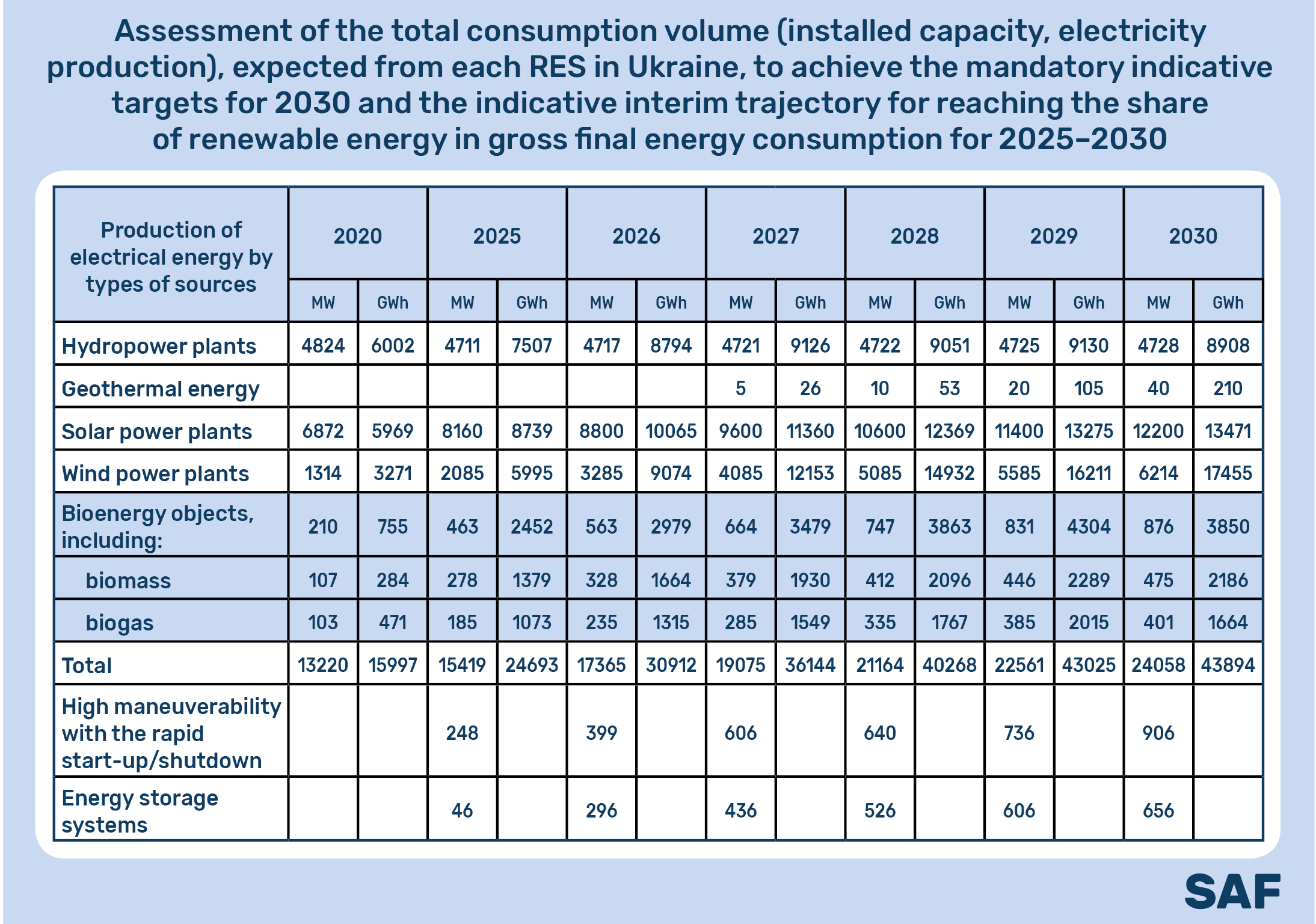
Barriers to the development of electricity and heat energy production from biomass:
- price instability of biofuels;
- unreliability of supply chains;
- low quality of biofuels.
However, the creation of a single competitive and transparent market for solid biofuels can help solve these problems.
In addition, it is necessary to align Ukrainian bioenergy terminology with EU legislation. In particular, definitions such as ‘biofuel,’ ‘bioliquid,’ and ‘biomass fuel,’ among others. Implementation of European legislation regarding the definition of sustainability criteria and greenhouse gas emissions is also necessary.
Using liquid and gaseous biofuels in the transport sector
In 2020, the gross final consumption of energy from RES in the transport sector amounted to 95 thousand toe (148 thousand toe when accounting for multipliers according to Directive 2009/28/EC). 51.1 thousand tons are — bioethanol/methyl tert-butyl ether produced from bioethanol.
To promote the development of liquid biofuels in the transport sector, the Verkhovna Rada of Ukraine amended several laws concerning the mandatory use of liquid biofuels (bio-components) in the transport industry:
- establishing a mandatory share of liquid biofuels (quotas) in the total annual volume of gasoline sales (5% by volume);
- implementing accounting and monitoring of bio-component content in gasoline;
- establishing responsibility (fines) for non-compliance with quotas;
- introduction of requirements for compliance with sustainability criteria for biofuels in the transport sector.
The implementation of these changes will contribute to:
- the development of bioethanol production in Ukraine;
- the using agricultural potential in the energy sector;
- workloads of distilleries;
- the increase of the country’s energy independence.
Moreover, developing the use of liquefied natural gas (LNG), compressed natural gas (CNG), and their biological counterparts is important.
By 2030, it is planned that the share of energy from renewable sources in the gross final energy consumption of the transport sector will be at least 17%, which, in natural terms, equates to 830 thousand toe.
The consumption of liquid biofuels (bioethanol, biodiesel) will account for 420 thousand toe, including: bioethanol from food and feed crops – 398 thousand toe, bioethanol from waste and residues (second generation) – 10 thousand toe, biodiesel from waste and residues (second generation) – 12 thousand toe. Additionally, the consumption of biomethane from waste and residues (second generation) will be 0.5 thousand toe.
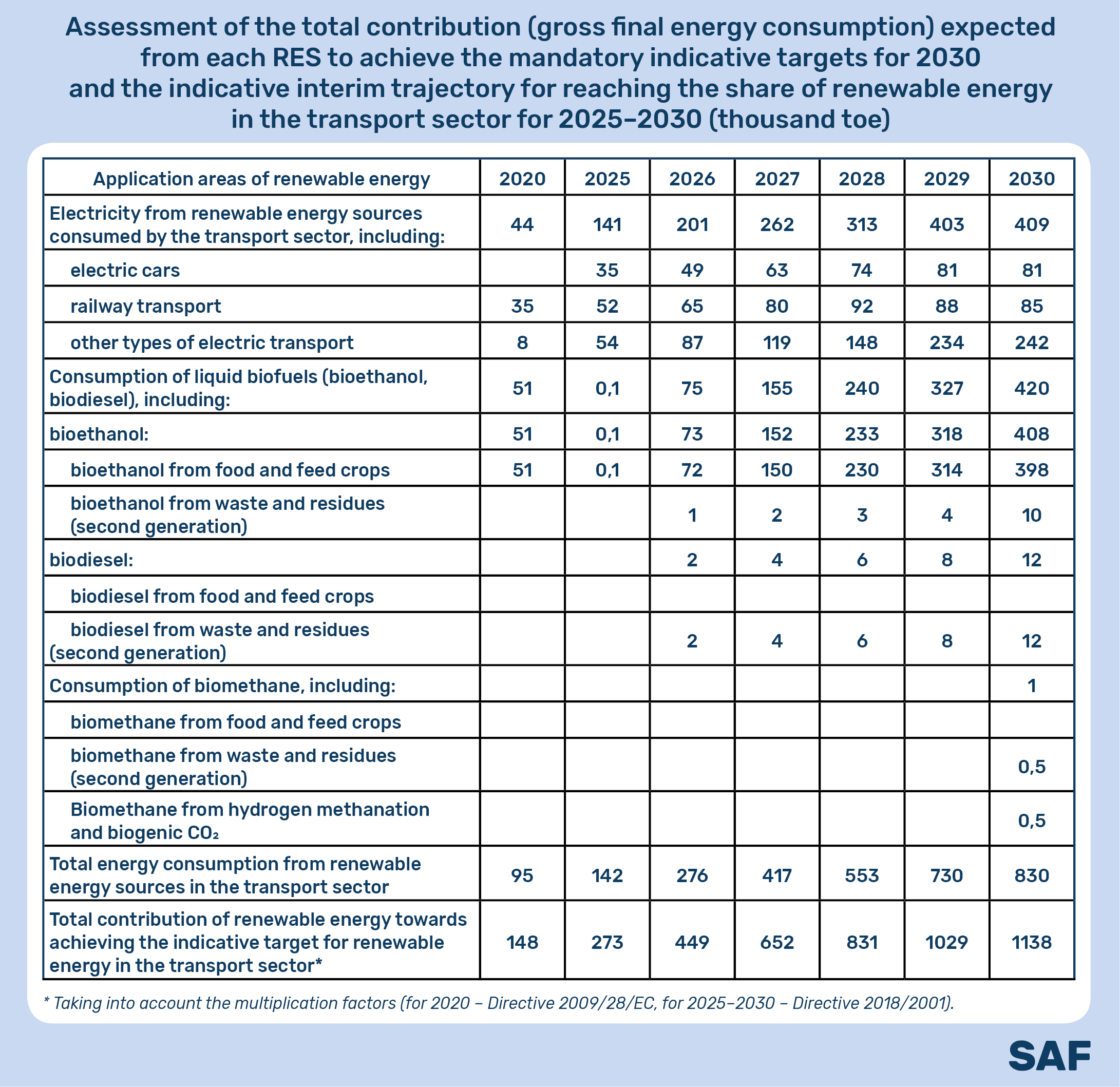
Biomethane
Biomethane is given significant attention in the National Plan. It can be used for directly replacing natural gas in the production of thermal and electrical energy. In the transport sector, biomethane can replace various types of motor fuels: compressed natural gas (CNG), gasoline, diesel, liquefied natural gas (LNG), and liquefied petroleum gas (LPG).
Producing biomethane through the upgrading of biogas will enable:
- to inject it into the gas grid;
- to transport it and produce electrical and thermal energy in locations with guaranteed thermal energy demand;
- to facilitate the import of biomethane to European Union countries.
Another promising direction for biomethane production is the integrated use of biomass. Biomethane plants, in addition to producing biomethane, generate digestate, which can become a key organic fertilizer needed for the restoration of Ukrainian soils.
The European Commission’s plan to phase out the consumption of russian fossil fuels by 2030 sets a goal to produce 35 billion cubic meters of biomethane per year. Ukraine has the potential to meet up to 20% of this demand. The total energy potential for the production of biogas/biomethane in Ukraine is estimated at 21.8 billion cubic meters per year (18.7 million toe per year).
Currently, a regulatory framework has been established that governs the legal, organizational, and economic foundations for the development of the biomethane sector. The Law of Ukraine ‘On Amendments to the Customs Code of Ukraine and other Laws of Ukraine regarding the Peculiarities of Customs Control and Customs Clearance of Certain Categories of Goods’ provides for the possibility of exporting biomethane to EU member states. During the transition period, the export of biomethane will be conducted according to the data provided by gas transportation/gas distribution system operators and documents verifying the volumes of biomethane, which confirmed the sustainability criteria.
Once the Ukrainian biomethane registry is implemented and connected to the EU database, it is expected that the export of biomethane will be conducted based on the data from the specified registry. Authorities are working on synchronizing the Ukrainian guarantee of origin registry with the EU database and on having Ukrainian guarantees of origin for biomethane recognized by the European Union.
Overall, the National Renewable Energy Action Plan until 2030 describes the EU legislative provisions that Ukraine must fully implement for accession. It is also important to conduct informational and explanatory campaigns among the general public regarding the use of renewable energy sources and alternative fuels in household. Furthermore, it is essential to create conditions for the training and retraining of Ukrainian professionals in the field of renewable energy sources and alternative fuels.
More detailed information on the National Renewable Energy Action Plan until 2030 can be found at the following link.: https://www.kmu.gov.ua/npas/pro-zatverdzhennia-natsionalnoho-planu-dii-z-vidnovliuvanoi-enerhetyky-na-p-a761.
This analysis for SAF Ukraine was prepared by Semen Drahniev, an expert at the Bioenergy Association of Ukraine.